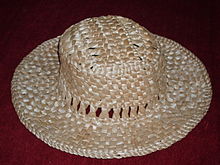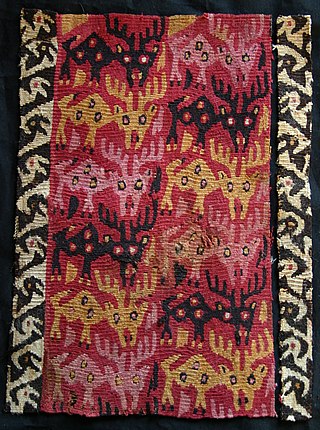


A straw hat is a wide-brimmed hat woven out of straw or straw-like synthetic materials. [1] Straw hats are a type of sun hat designed to shade the head and face from direct sunlight, but are also used in fashion as a decorative element or a uniform.



A straw hat is a wide-brimmed hat woven out of straw or straw-like synthetic materials. [1] Straw hats are a type of sun hat designed to shade the head and face from direct sunlight, but are also used in fashion as a decorative element or a uniform.
Commonly used fibers are: [2]
There are several styles of straw hats, but all of them are woven using some form of plant fibre. [15] [16] Many of these hats are formed in a similar way to felt hats; they are softened by steam or by submersion in hot water, and then formed by hand or over a hat block. Finer and more expensive straw hats have a tighter and more consistent weave. Since it takes much more time to weave a larger hat than a smaller one, larger hats are more expensive.[ citation needed ]
Straw hats have been worn in Africa and Asia since after the Middle Ages during the summer months, and have changed little between the medieval times and today. They are worn, mostly by men, by all classes. Many can be seen in the calendar miniatures of the Très Riches Heures du Duc de Berry.

The mokorotlo , a local design of a straw hat, is the national symbol of the Basotho and Lesotho peoples, and of the nation of Lesotho. It is displayed on Lesotho license plates.
Betsey Metcalf Baker (née Betsey Metcalf; 1786–1867) [17] was a manufacturer of straw bonnets, entrepreneur, and social activist based in Providence, Rhode Island and Westwood, Massachusetts. At age twelve, she developed a technique for braiding straw, allowing her to emulate the styles of expensive straw bonnets and make them accessible to working-class women. Rather than patent her technique, Baker taught the women in her community how to make straw bonnets, enabling the development of a cottage industry in New England. [18]
Because of the Napoleonic Wars, the United States embargoed all trade with France and Great Britain for a time, creating a need for American-made hats to replace European millinery. The straw-weaving industry filled the gap, with over $500,000 ($9 million in today's money) worth of straw bonnets produced in Massachusetts alone in 1810. [19]
On May 5, 1809, Mary Dixon Kies received a patent for a new technique of weaving straw with silk and thread to make hats. [20] [21] Some sources say she was the first woman to receive a US Patent, [22] [23] however other sources cite Hannah Slater in 1793, [24] [25] [26] or Hazel Irwin, who received a patent for a cheese press in 1808, [27] [24] as the first.
President Theodore Roosevelt posed for a series of photos at the Panama Canal construction site in 1906. He was portrayed as a strong, rugged leader dressed crisply in light-colored suits and stylish straw fedoras. This helped popularize the straw "Panama hat". [28]
The Old Order Amish, in the United States, still wear straw hats (similar to a Boater Hat), especially in the summer months. In the winter, or for formal wear, they will wear a felt hat.
Artwork produced during the Middle Ages shows, among the more fashionably dressed, possibly the most spectacular straw hats ever seen on men in the West, notably those worn in the Arnolfini Portrait of 1434 by Jan van Eyck (tall, stained black) and by Saint George in a painting by Pisanello of around the same date (left). In the middle of the 18th century, it was fashionable for rich ladies to dress as country girls with a low crowned and wide brimmed straw hat to complete the look. [29]
Mary Dixon Kies was an American inventor. On May 5, 1809, her patent for a new technique of weaving straw with silk and thread to make hats was signed by President James Madison.

A hat is a head covering which is worn for various reasons, including protection against weather conditions, ceremonial reasons such as university graduation, religious reasons, safety, or as a fashion accessory. Hats which incorporate mechanical features, such as visors, spikes, flaps, braces or beer holders shade into the broader category of headgear.

A Panama hat, also known as an Ecuadorian hat, a jipijapa hat, or a toquilla straw hat, is a traditional brimmed straw hat of Ecuadorian origin. Traditionally, hats were made from the plaited leaves of the Carludovica palmata plant, known locally as the toquilla palm or jipijapa palm, although it is a palm-like plant rather than a true palm.

A boater is a semi-formal summer hat for men, which was popularised in the late 19th century and early 20th century.

Waraji are light tie-on sandals, made from ropemaking fibers, that were the standard footwear of the common people in Japan.

Corypha or the gebang palm, buri palm or talipot palm is a genus of palms, native to India, Malaysia, Indonesia, the Philippines, New Guinea and northeastern Australia. They are fan palms, and the leaves have a long petiole terminating in a rounded fan of numerous leaflets.

Straw plaiting is a method of manufacturing textiles by braiding straw and the industry that surrounds the craft of producing these straw manufactures. Straw is plaited to produce products including straw hats and ornaments, and the process is undertaken in a number of locations worldwide.

Salakót is a traditional lightweight headgear from the Philippines that is commonly used during pre-colonial era up to the present day, used for protection against the sun and rain. Every ethnolinguistic group in the archipelago has their own variant, but they are all usually dome-shaped or cone-shaped and can range in size from having very wide brims to being almost helmet-like. They are made from various materials including bamboo, rattan, nito ferns, and bottle gourd. The tip of the crown commonly has a spiked or knobbed finial made of metal or wood. It is held in place by an inner headband and a chinstrap. The salakot hat also influenced the pith helmet used by European colonizers. Salakot or also spelled as salacot in Spanish and salacco in French is the direct precursor to the pith helmet widely used by European military forces in the colonial era.

A sun hat is any hat or headgear specifically designed to shade the face, neck and shoulders from direct sunlight, usually with a circumferentially-protruding semi-rigid brim that can range from small to large, but as a general guideline around 4 to 7 in in width.

A bergère hat is a flat-brimmed straw hat with a shallow crown, usually trimmed with ribbon and flowers. It could be worn in various ways with the brim folded back or turned up or down at whim. It is also sometimes called a milkmaid hat. It was widely worn in the mid-18th century, and versions may be seen in many British and French paintings of the period, such as The Swing by Fragonard, and in portraits by Thomas Gainsborough and Johann Zoffany, amongst others. It has been suggested that the hat was named after Madame Bergeret, who is holding a shepherdess-style hat in a Boucher portrait painted c.1766.

The textile arts of the Indigenous peoples of the Americas are decorative, utilitarian, ceremonial, or conceptual artworks made from plant, animal, or synthetic fibers by Indigenous peoples of the Americas.

Sybilla Righton Masters was an American inventor. Masters was the first person residing in the American colonies to be given an English patent, and possibly the first known female machinery inventor in America of European ancestry. Masters was given a patent for a corn mill in 1715 in her husband's name, as women were not allowed to have their own patents. She also patented a process for making hats.
Andrés Uc Dzul (1910–2004) was a Mexican artisan specializing in the creation of palm hats, especially Panama hats. His work was in great demand in the first half of the 20th century, and he was later recognized as a “grand master”.

A halo hat is a millinery design in which the headgear acts as a circular frame for the face, creating a halo effect. The design is said to date back to the late 19th century, when it was known as the aureole hat; this name is sometimes still used. It may also be known as the angel hat or bambini – the latter said to derive from Italian for terracotta plaques depicting the infant Christ.

A Eugénie hat is a small women's hat that is usually worn tilted forwards over the face, or it may be angled low over one eye. Typically, it is made of velvet or felt, although a variety of materials may be used. The classic design also has a plume of feathers, although other trims may be used.

The Chapeau à la Paméla, Pamela hat or Pamela bonnet described a type of straw hat or bonnet popular during the 1790s and into the first three quarters of the 19th century. It was named after the heroine of Samuel Richardson's 1741 novel Pamela; or, Virtue Rewarded. While Pamela hats and bonnets underwent a variety of changes in shape and form, they were always made from straw. The mid-19th-century version of the Pamela hat was a smaller version of an early 19th-century wide-brimmed style called the gipsy hat.

The buntal hat is a traditional straw hat from the Philippines woven from fibers extracted from the petioles of buri palm leaves. It is traditionally worn by farmers working in the fields and was a major export of the Philippines in the first half of the 20th century. It can also be paired with semi-formal barong tagalog as well as informal attire. Its main centers of production are Baliwag, Bulacan, and (historically) Sariaya and Tayabas in Quezon Province. Buntal hats produced in Baliwag are also sometimes known as balibuntal hats, and are regarded as superior in quality to other types of buntal hats.
Buntal may refer to:

A shepherd's hat is a head covering, used by a shepherd to ward off the sun and the elements. Along with a crook, it is an important tool for the shepherd.